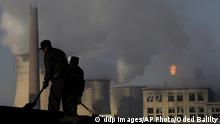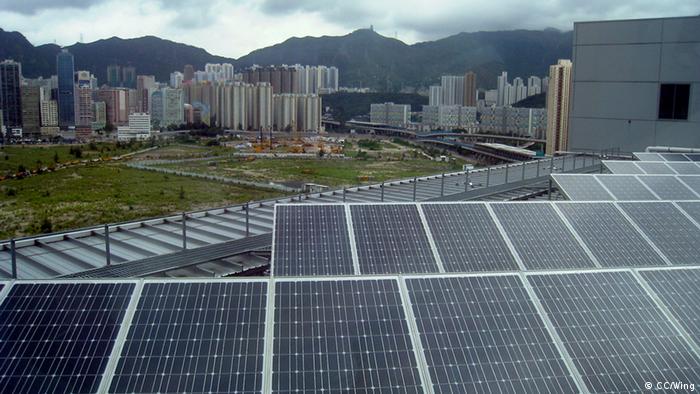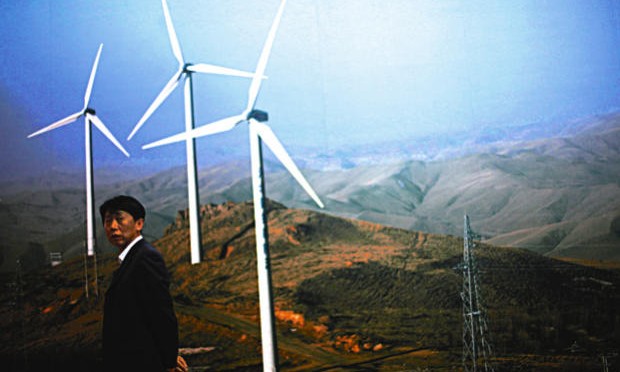Current plans include quadrupling wind power, photovoltaic and biomass capacities from 50 gigawatts in 2010 to 200 gigawatt by the year 2020, and 3 GW of concentrated solar power.
The international community welcomed the news that China was investing in renewable energy, and the news didn’t stop there. Beijing continues to surpass itself in setting ever more ambitious targets.
Current plans include quadrupling wind power, photovoltaic and biomass capacities from 50 gigawatts in 2010 to 200 gigawatt by the year 2020. Á European city with a population of 500 million consumes on average just one gigawatt a year.
China passed its first renewable energy law in 2005 and in subsequent years advanced to the position of world leader in clean energy technology. According to Worldwatch Institute, the country is the world number one in manufacturing energy-saving lamps, wind farms and photovoltaic modules. Thanks to early state investment, China is also ahead of the game when it comes to energy-efficient stoves and solar thermal collectors.
According to the International Energy Agency (IEA), China meets 17 percent of its primary energy needs with oil and 3.4 percent with gas. In comparison, the 27 countries that make up the EU rely on oil for 35 percent of their needs and gas for 25 percent.
The main energy source in China is coal, which is used to generate 67 percent of the country’s energy supply. Beijing is now investing heavily in the nuclear sector, but for the time being, it delivers significantly less energy than it does in the U.S. and the EU. Supplying 12 percent of China‘s energy needs, renewable energy is a stronger industry than it is in Europe (10 percent) and the U.S. (6 percent). Nine percent of this energy comes from biomass, biogas and biodegradable waste and 2.3 percent from hydropower, while wind power, solar power, geothermal power and tide and wave power provide 0.5 percent.
Ambitious targets
Developing at an equally fast pace is the Chinese capacity to produce clean electricity. No other country in the world has invested in the renewable energy sector to the extent that China has. Its first priority is wind power, the top regenerative energy source after biomass, which includes traditional fuels such as dung, wood, bio-waste and biogas.
Moreover, China is planning a series of large-scale dams that will deliver a further 120 gigawatts of electricity – as much as 120 nuclear reactors. Beijing aims to double its current wind energy production to 100 gigawatts by 2015. The third priority is photovoltaic technology, with production set to be raised to 15 gigawatts over the next 5 years. China also considers nuclear power to be a clean source of energy and is planning 25 new reactors which will boost current energy production capacities eightfold by the year 2015.
 On average, China adds one new coal power plant per week to its grid.
On average, China adds one new coal power plant per week to its grid.But for the time being, coal is still used to generate 80 percent of the country’s electricity. Statistically, China adds one new coal power plant per week to its grid – much to the dismay of the government.
“And of the public!” stresses Susanne Langsdorf, a China expert at the environmental institute Ecologic. “Air pollution is a problem discussed on a daily basis, especially in the cities.”
Environmental goals, economic priorities
The boom in renewable energy offers an alternative to dependency on coal – a dependency that is fatal for the population, with respiratory disorders claiming thousands of lives every year. Another factor is the need to curb the country’s massive industrial energy consumption, which is costing China a fortune now that oil and gas prices are rising. Once a country that exported oil well into the 1990s, it now has to import half its oil supply.
“Use of resources needs to be separated from economic growth,” explains environmental economist Claudia Kemfert from the German Institute for Economic Research. “Otherwise it will be hard to maintain.”
Economic growth is both a curse and a blessing for China. Beijing wants the country to become cleaner, more efficient and therefore also more affordable – but at the same time, it doesn’t want growth jeopardized by China’s climate protection commitments. Even though the country is now the world’s biggest carbon dioxide emitter, it has set itself the relatively modest target of reducing its carbon dioxide emissions per unit of GDP by 40 to 45 percent, and that between 2005 and 2020. Ultimately, this means no actual reduction of CO2 emissions, simply a slower increase. Announced in early 2010, China’s carbon intensity target also includes commitments to climate protection already made in 2005. To many, the pledge is therefore somewhat bogus.
Internal conflict
China’s environmental efforts certainly seem to warrant a closer look. “There is a lot being done, but there are also many internal problems,” says Langsdorf, who spent time working on energy issues at the Friedrich Ebert Foundation in Shanghai. “One of them is that it is not clear who is responsible for what.” The reason being that China has no environment ministry and no centralized environmental policy.
Further problems include corruption within many regional administrations and a shortage of trained staff and funds. Along with the powerful State Council, three national bodies are responsible for environmental policy. The National Development and Reform Commission (NDRC) dictates energy prices. Reporting to this is the National Energy Administration (NEA), established in 2008. Meanwhile, the National Energy Commission (NEC) lead by Premier Wen Jiabao is in charge of overall coordination.
The issue of inefficiency
Internal communication and coordination problems aside, another sticking point is energy efficiency – an issue where there is clearly room for improvement. Studies show that there is a saving potential of 50 percent in China. But in order to make this happen, millions of households and power plants would need renovating.
“Progress is very slow,” states Susanne Langsdorf. “It is also hampered by the slow pace of grid expansion, a problem Europe also faces.” One third of China’s wind farms are still not part of the grid even though Beijing is investing $100 billion in extending the grid.

Also set to profit from this in the medium term is the solar sector, which is still very much a fledgling industry in China. It will soon begin to grow now that the government has set a feed-in tariff for solar power – just as Germany did a few years ago. It means that anyone who feeds solar power into the grid receives fixed remuneration.
But the German solar industry – used to being the world leader and increasingly nervous about Chinese competition – is skeptical about China’s hunger for energy and resources. “Chinese companies are taking a great interest in German firms mainly because of their patents,” says Freiburg-based energy journalist Bernward Janzing. Investors from Beijing already own considerable stakes in photovoltaic companies like Sunways as well as Portugal’s electricity giant EDP.
Chinese investment in Europe is fast becoming a defining feature of the global economy.
Author: Torsten Schäfer, Editor: Sumi Somaskanda, http://www.dw.de/


